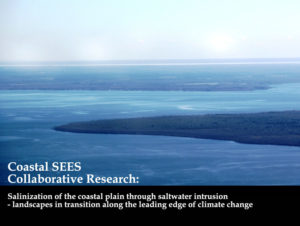 Climate change is transforming the outer edge of the Southern U.S. coastal plain. A new $1.5 million National Science Foundation grant ($357,000 of which will go to UNC through the Institute for the Environment) will fund research in this area, in partnership with other Triangle universities.
Climate change is transforming the outer edge of the Southern U.S. coastal plain. A new $1.5 million National Science Foundation grant ($357,000 of which will go to UNC through the Institute for the Environment) will fund research in this area, in partnership with other Triangle universities.
Lower-lying parts of this region, characterized by extensive freshwater-dependent ecosystems, will be largely inundated by gradual sea level rise by the end of this century. In the interim, however, ocean waters are already penetrating and influencing freshwater-dependent coastal landscapes due to a combination of human and natural factors. This landward movement of salinity from the coast onto the coastal plain or “saltwater intrusion” represents the leading edge of climate change for many coastal landscapes.
The new project, involving Todd BenDor, associate professor in the department of city and regional planning, will bring together investigators from four major N.C. universities (NC State, Duke, UNC and ECU) and four disciplines (hydrology, biogeochemistry, community ecology, regional planning). The team will work to integrate social, hydrological, climate and ecological data to examine not only how human decisions affect ecosystems but also how information about those ecological impacts in turn affect human decisions.
BenDor’s research and teaching focus on producing better ways to understand the impacts that human activities and development can have on sensitive ecological and environmental systems.
This project will involve development, validation and refinement of a saltwater intrusion vulnerability index for the Albemarle-Pamlico peninsula of North Carolina. It will account for physical environmental processes influencing the movement of water and solutes across the landscape, as well as the extensive networks of canals, ditches, roads and pump stations that fundamentally alter the flow of water across the region. The index will be used, along with extensive and repeated ground-based surveys of surface water, soil and vegetation conditions across a range of vulnerable landscapes within the region, to better understand ecological impacts of saltwater intrusion.
Read more here.



